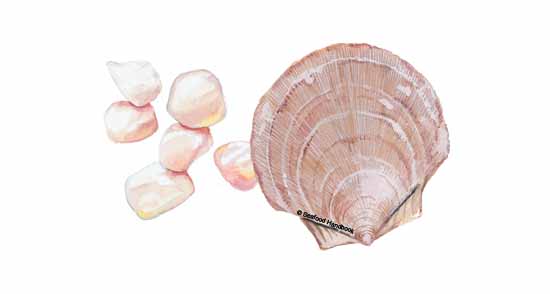Scallop, Sea
Published on
January 23, 2014

This species supports the largest scallop fishery in the world. Sea scallops are dredged year-round from Labrador to New Jersey. Since sea scallops die out of water, they are always shucked at sea and kept on ice, if not frozen aboard. The meat counts range from 20 to 40 per pound. New Bedford, Massachusetts, is the largest sea scallop port, and the auction there usually sets the price. Virginia, New York and New Jersey are also important suppliers. Sea scallops are farmed in New England and Newfoundland, but production is limited. Only the adductor muscle, which allows scallops to “swim” by clicking their shells together, is eaten. This mobility helps them escape pollutants that immobile bivalves like mussels, clams and oysters can’t avoid. Avoid “wet” scallops that have soaked too long in chemical additives designed to maintain texture and taste. They’ll be flabby and opaque and will shed water and weight rapidly.
Placopecten megallanicus
Scallop
Sea scallop
Pétoncle
Atlantischer Tiefwasser-Scallop
Hotategai
Vieira
This species supports the largest scallop fishery in the world. Sea scallops are dredged year-round from Labrador to New Jersey. Since sea scallops die out of water, they are always shucked at sea and kept on ice, if not frozen aboard. The meat counts range from 20 to 40 per pound. New Bedford, Massachusetts, is the largest sea scallop port, and the auction there usually sets the price. Virginia, New York and New Jersey are also important suppliers. Sea scallops are farmed in New England and Newfoundland, but production is limited. Only the adductor muscle, which allows scallops to “swim” by clicking their shells together, is eaten. This mobility helps them escape pollutants that immobile bivalves like mussels, clams and oysters can’t avoid. Avoid “wet” scallops that have soaked too long in chemical additives designed to maintain texture and taste. They’ll be flabby and opaque and will shed water and weight rapidly.
The largest commercially available scallops, sea scallops have a sweet, rich taste that ranges from mild to briny. Raw, the drum-shaped meat is a shiny, creamy white, sometimes with pinkish or brown spots. Top-quality scallops should have an ivory translucence and elastic springiness that allows them to keep their shape. Cooked meat is opaque white with a firm, lean texture.Scallops are generally less susceptible to contamination than other shellfish, primarily because normally only the well-guarded adductor muscle is eaten. Still, persons in high-risk health categories should not eat them raw.
| Calories: | 87 |
| Fat Calories: | 7 |
| Total Fat: | 0.8 g |
| Saturated Fat: | 0.8 g |
| Cholesterol: | 33 mg |
| Sodium: | 161 mg |
| Protein: | 16.8 g |
| Omega 3: | 0.2 g |
Though they may be large, sea scallops still cook quickly. Recipes often suggest cutting them in half across the grain before cooking, but the large size makes sea scallops a natural for the grill. Don’t microwave scallops — they can explode at higher settings.
Bay scallops
- Bake
- Boil
- Broil
- Fry
- Grill
- Pate
- Poach
- Saute
- Smoke
- Steam
Fresh: Meats
Frozen: Meats (IQF or block)
Value-added: Breaded/battered, Entrées
Argentina, Canada, Chile, Iceland, Japan, Russia, United States





